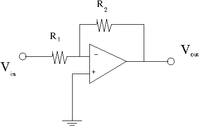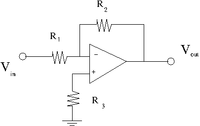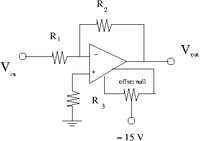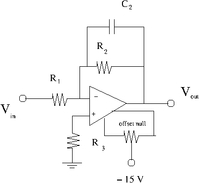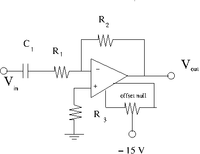Difference between revisions of "TF EIMLab23 Writeup"
| Line 88: | Line 88: | ||
Measure the slew and compare it to the factory spec. | Measure the slew and compare it to the factory spec. | ||
| + | |||
| + | |||
| + | The slew rate for the 741 is 0.5V/microsecond compared to 100V/microsecond for a high-speed op-amp. | ||
=Power Supply Rejection Ratio= | =Power Supply Rejection Ratio= | ||
Revision as of 02:42, 19 April 2011
Inverting OP Amp
1. Construct the inverting amplifier according to the wiring diagram below.
Here is the data sheet for the 741 Op Amp
Use and as starting values.
2. Insert a 0.01 F capacitor between ground and both Op Amp power supply input pins. The Power supply connections for the Op amp are not shown in the above circuit diagram, check the data sheet.
Gain measurements
1.) Measure the gain as a function of frequency between 100 Hz and 2 MHz for three values of = 10 k, 100 k, 1M. Keep at .
2.)Graph the above measurements with the Gain in units of decibels (dB) and with a logarithmic scale for the frequency axis.
Impedance
Input Impedance
- Measure for the 10 fold and 100 fold amplifier at ~100 Hz and 10 kHz frequency.
For the 741 the input resistance measured to one input with the other grounded is about 2 Megohms.
Output Impedance
- Measure for the 10 fold and 100 fold amplifier at ~100 Hz and 10 kHz frequency. Be sure to keep the output () undistorted
For the 741 it is about 75 ohms but can be as high as several thousand ohms for some low power op-amps. The effective output impedance is further lowered by the use of negative feedback, so the focus becomes not one of the number of ohms looking into the output, but what limitations are placed on the output current. Limiting the output current also limits the allowable output voltage swing: the lower the load resistance, the lower the allowable voltage amplitude. For a load >2K, the 741 can swing to within about 2 volts of the supply. This is about all that is permitted by common mode limits for a 15 volt supply so the output impedance is not a serious limitation.
and
Use the above equation and two measurements of , , and to extract and .
- measure for = 1 k, = 100 k, and=0 (grounded).
- measure for = 10 k, = 1 M, and=0 (grounded).
- You can now construct 2 equations with 2 unknowns and .
Now we will put in a pull up resistor as shown below.
Instead of the current we have the current
Use the same technique and resistors from the previous section to construct 2 equations and 2 unknowns and extract , keep =0.
The offset Null Circuit
- Construct the offset null circuit above.
- Adjust the potentiometer to minimize with .
- Use a scope to measure the output noise.
Capacitors
- Revert back to the pull up resistor
Capacitor in parallel with
- Select a capacitor such that when = 10 kHz.
- Add the capacitor in parallel to so you have the circuit shown above.
- Use a pulse generator to input a sinusoidal voltage
- Measure the Gain as a function of the frequency and plot it.
Capacitor in series with R_1
- Select a capacitor such that when = 1 kHz.
- Add the capacitor in series to so you have the circuit shown above.
- Use a pulse generator to input a sinusoidal voltage
- Measure the Gain as a function of the frequency and plot it.
Slew rate
Measure the slew and compare it to the factory spec.
The slew rate for the 741 is 0.5V/microsecond compared to 100V/microsecond for a high-speed op-amp.
Power Supply Rejection Ratio
- Set V_{in} = 0.
- Measure while changing
